-
Administrator

1970 Trans-Am Championship
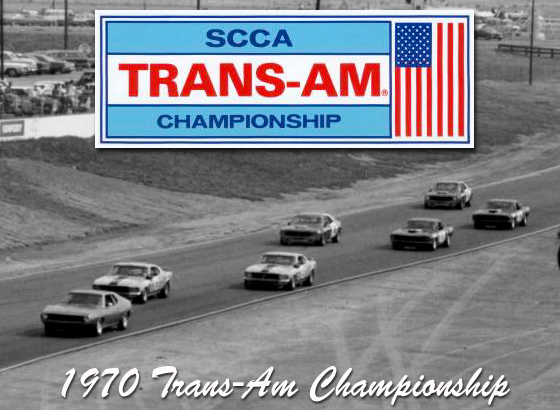
Other than a brief hiatus between 2007-09, the Sports Car Club of America (SCCA) Trans-American Sedan Championship has run non-stop since 1966. But, despite its longevity, the series has never quite managed to rediscover the giddy heights it enjoyed between 1967-70.
1967 saw a full-blown Ford effort through a two-pronged Ford Mustang/Mercury Cougar attack, while General Motors provided unofficial support to Roger Penske’s Camaro team. Mercury withdrew in 1968, but was replaced by a two-car American Motors Javelin team which produced some good results, if not race wins. Craig Fisher entered a Firebird fitted with a Chevy motor, and this became a quasi-factory effort when Canadian Terry Godsall became involved. Frustrated by the disastrous season he was having with Ford, ’67 Trans-Am champion Jerry Titus hopped into a second Godsall Firebird for the final 1968 race.
Ford stepped up their efforts in 1969, financing a pair of two-car factory Mustang teams for Carroll Shelby and Bud Moore, and along with factory efforts from Pontiac, Chevrolet, and American Motors, most Trans-Am races throughout the ’69 season boasted at least ten factory cars duking it out.
-
Administrator

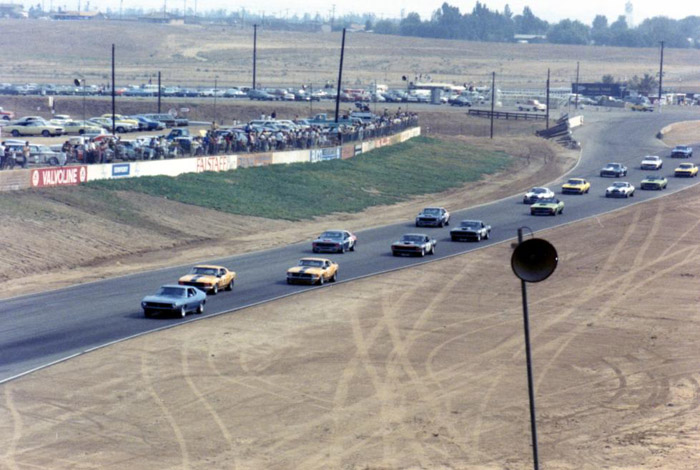
The only American manufacturer not involved by 1969 (they’d run factory cars in 1966 only) was Chrysler, but they rectified that by supporting a pair of factory teams, run by Dan Gurney (AAR Plymouth Cuda’s), and Ray Caldwell/Sam Posey (Autodynamics Dodge Challengers). The 1970 SCCA Trans-Am Championship, held over 11 rounds, would be the most competitive, most fiercely contested in the categories short existence.
Ford had slashed its racing budget for 1970, and halved its Trans-Am efforts with a single two-car team for Bud Moore, driven by Parnelli Jones and George Follmer. The big news over the off-season was the switching of brands for two-time champions Penske Racing, from General Motors to American Motors, where they’d take over the running of the AMC Javelins. They’d run two cars for Mark Donohue and Peter Revson. So G-M called upon Jim Hall to run a two-car Camaro team, with himself and Ed Leslie doing the driving. Given Hall’s reputation at the time, his strong G-M ties, and his fleet of ground-breaking Can-Am sports cars, Hall’s Chaparral Camaro team went into the 1970 Trans-Am as favourites. The final factory team would be the T/G Racing Pontiac Firebird of Jerry Titus.
As well as the factory teams, there would be a two-car Camaro team with strong G-M factory ties. Additionally, Roy Woods would run a pair of older ’69 Camaros, for drivers Milt Minter and Woods himself. Additionally, the Trans-Am fields would be padded out with a vast array of privateer teams at each venue.
The 1970 Trans-Am kicked off at Laguna-Seca on April 19, 1970. Both the ’70 model Camaros and Firebirds appeared without their front and rear spoilers, and the Firebirds without their rear-facing hood scoop, as G-M workers strikes meant not enough cars had been built and sold yet for these items to be homologated. Qualifing saw Parnelli Jones on pole, with Donohue in the Javelin lining up next to him, while Follmer and Gurney were on row two.
At the drop of the flag, and Parnelli was gone, leading Donohue until the first round of pit stops. He eventually re-took the lead, and was first to see the chequer, after 90 laps, with Donohue 40 seconds behind, and Follmer a lap back in third. Of the factory cars, neither Leslie, Gurney, Revson, or Hall made the finish, and the Bud Moore team were the only ones who could feel confident about the season ahead, possessing cars that were both fast and strong.
Round 2 was due to take place one week later, at Dallas, but heavy rain and flooding of the track and infield saw its cancellation, and the Trans-Am circus moved on to Lime Rock Park, on May 9. Donohue this time grabbed the pole, with Gurney lining up next to him in the AAR Cuda, while Jones and Leslie were on row two.
From the rolling start, Follmer burst through to take the lead from Donohue, while Gurney played catch-up until his cutch failed on lap 64. Donohue wrung the Javelins neck trying to keep pace with Jones, but his engine failed 8 laps later, and the school bus yellow Mustang was first to the line once again, though with failing front brakes and a broken pushrod, evidence of Parnelli’s aggressive driving style. Leslie finished second, one lap behind Jones, while Sam Posey worked his way through to third from tenth on the grid. Hall finished fourth, but a whopping 11 laps behind the winner. None of the other factory cars made it to the finish.
-
Administrator

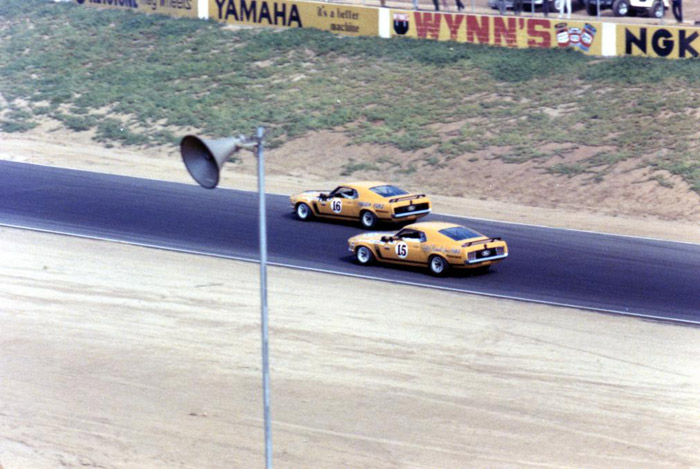
Round 3 of the series was held at Bryar, on May 31, and would be without the presence of Gurney, who’d announced he was to quit his Trans-Am duties in favour of Formula 1 and Indy Cars, and although he didn’t know it at the time, he’d be called upon by Team McLaren to drive its second M8D Can-Am car, as its leader would be killed a few days later. So Savage would step up to the #48 Plymouth, and AAR would run just a single car, but he brought Plymouth their first Trans-Am pole position of the season. Jones would again be on the front row, while an impressive Posey was next in the Challenger, alongside Donohue.
Jones again stormed off into a strong lead, with Follmer moving through into second. Savage retired, with transmission failure on lap 33. Jones looked likely to take his third win from three starts, until his hood blew off and he was black-flagged, leaving the race win to his team-mate. Revson and Donohue were distant podium placings.
At a press conference in Los Angeles on signing with American Motors, Roger Penske announced to everyone that the Penske Javelins would win at least seven races in the 1970 Trans-Am, but after three rounds, it seemed nobody had an answer for the flying Bud Moore Mustangs, and while Penske were looking a little lost, they were still looking much better than the other factory teams.
Mid-Ohio was the host for round four, on June 7, and Ed Leslie cut a good lap in qualifying to put the white Chaparral Camaro on pole, ahead of Donohue’s Javelin, Next up were the Bud Moore team mates, and at the green, the pair swamped the front row and proceeded to engage in their own inner-team battled for the race win, which Jones won, by 0.3 second. Donohue was a distant third. Posey, in fifth, had to suffer the stigma of being beaten by privateer Mo Carters Camaro, by just 0.4 second, but at least he finished. The other factory cars were nowhere.
The swoopy, curvaceous, undulating Bridgehampton hosted round five of the championship, and again Savage lined the big blue Cuda up on pole. He led the early laps, until rain began to fall, and Donohue swept through into a lead he would hold to the finish. Donohue had been working with Goodyear engineers to produce a superior rain tyre, and he would credit this as being the reason for his win. Interestingly, prior to Bridgehampton, American Motors management had arranged a meeting with Penske following the race, in which they had planned to severe their contract, but Donohue’s breakthrough victory changed their minds. Follmer and Jones finished the race second and third.
Donnybrooke on June 5 would be the venue for round six, and again Savage claimed pole, while Jones lined up on the outside front row. Next up were Leslie and Follmer. And despite the factory muscle on offer, it was privateer Milt Minter, in his year old ’69 Camaro who was first to the line. With retirements from Jones, Donohue, Posey, Leslie, and Titus, Minter went at Follmer, and came out on top. The pair battled hard throughout the race, chasing after the flying Savage at first, but when he slowed with a gearbox jammed in 2nd, they found themselves squabbling over the lead. On the last lap the pair touched, Follmer was delayed slightly, and Minter charged off to a popular win, the first for an independent driver since February 1967. Embarrassingly, the only factory Camaro to make the finish, that of Joe Leonard, who was filling in for Hall, finished fourth, behind the second Roy Woods Camaro.
-
Administrator

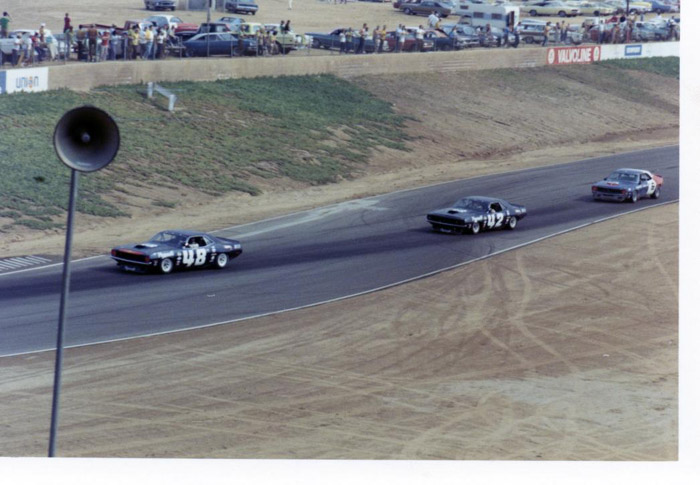
Round seven of the championship was held at Elkhart Lake, and would best be remembered as the event in which the popular Jerry Titus lost his life when the steering failed on his Firebird, and he careened into a bridge abutment in Saturday practice. It would take 17 days before he succumbed to his injuries.
Jones was on pole, with his team-mate alongside, but it was Donohue who won the race, thanks to a clever plan by Roger Penske to bring his driver in early, fill the car with fuel, and send him back out where he’d he able to run fast laps all afternoon in clear traffic. Trans-Am cars had to make at least one pitstop for fuel to make race distance, and most started the race on full tanks, then stopped later in the race to make the finish. Penske reversed the cycle, and Donohue won American Motors its second Trans-Am race.
Follmer made it as far as turn one when Leslie went spearing through the middle of the two Mustangs, and all three left the track. Jones and Leslie recovered, but the Camaro driver was black-flagged for his efforts. Savage finished second, just under 1 minute behind, while Posey notched up a good result in the Challenger for third.
On to Canada and Mt. Tremblant, and Bud Moore had entered three cars, with A.J Foyt fronting up to support Jones and Follmer. However, he didn’t even get to start, as Jones wrecked his car in practice. Hall had decided to step out of the second Chaparral Camaro and plugged Vic Elford into the drivers seat instead. Jones was on pole, with Donohue’s Javelin next, while Follmer and Leslie shared row two.
Penske again brought Donohue in early for fuel, and again the red, white, blue Sunoco Javelin reached the finish first, with Follmer and Jones trailing well behind.
Watkins Glen was the location for Round 9, and Jones and Donohue again shared the front row, with Elford and Posey next. Jones led Donohue for the first 30 laps, until the heavens opened, and suddenly Elford began moving his way to the front from fifth where he’d been for much of the race. He eventually pushed through to lead, and drew out a comfortable margin, until eventually the rain stopped, and the track began to dry. Then Donohue, now lying second, began closing the gap, but ran out of time, and finished just under 10 seconds behind the Camaro driver, while Follmer placed third.
With two rounds left, Ford had all but wrapped up the championship (there was no driver championship until 1971). But with teams looking towards the 1971 season, efforts were made to make a good impression with a view to negotiating contracts. At Kent, Dan Gurney stepped back into the second AAR Cuda which had been laying dormant, while Ray Caldwell had a second Challenger constructed for Ronnie Bucknum to drive. Terry Godsall, who’d hired John Cordts to take over the Titus Firebied, entered a second car for David Hobbs.
Parnelli Jones and his Bud Moore Mustang had been the class act throughout 1970, and he underlined this by taking pole position at Kent, then jumped into the teams spare car, went out, and nailed the second fastest time, just to twist the knife a little more. Donohue was next, from the returning Gurney, and Follmer.
At the drop of the green, Jones soared away from the field at the rolling start, led every lap, and finished just under 20 seconds ahead of Donohue after 200 miles. Posey notched up another good result in third. Ford had sealed the 1970 Trans-Am championship.
-
Administrator

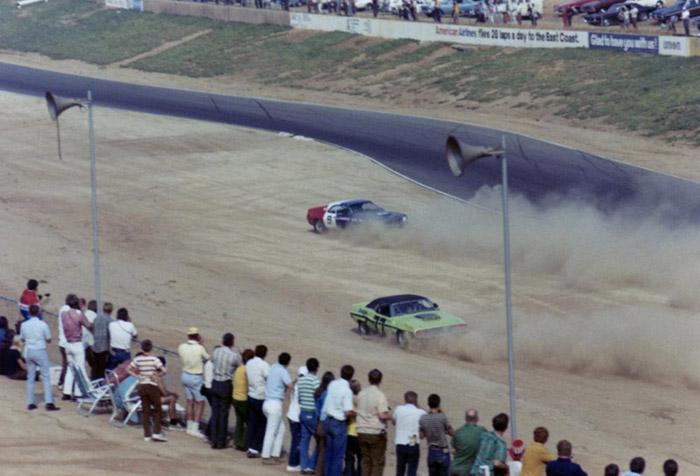
The magnificent flowing Riverside circuit was the venue for the final round of the 1970 Trans-Am Championship. Tony Adamowicz was drafted in to replace Bucknum at Autodynamics, while Jerry Thompson would replace John Cordts in the second T/G Firebird. Gurney announced he was retiring from driving following the Riverside race to spend more time on his managerial duties with AAR.
Jones grabbed pole, and broke the lap record in the process, then charged into the distance at the start, building a healthy lead until he clobbered a back-marker when lapping him. So violent was the hit that the Mustang became airborne as it flew off the track. Jones scrambled to get pointed in the right direction, and set off again, having dropped back to ninth. Follmer led the race, but Jones was on a mission, and he set the fastest lap as the battered Mustang soared back through the field to lie second, then inherited the lead when Follmer slowed.
The two Bud Moore Mustangs placed first and second at the finish, with Donohue third. Posey collected Revson, and the pair had a punch-up after the race. Tempers were frayed.
Behind Ford in the championship, AMC was next, followed by Chevrolet, Dodge, and Plymouth.
And then, following what had been the most dramatic, best supported, most fiercely contested season to date, the Trans-Am fell to bits. Ford announced it was to withdraw from all forms of motorsport. Chrysler decided to concentrate its motorsport efforts on drag racing and Nascar, and dropped the Trans-Am. Jim Hall and Chevrolet just sort of chose not to continue, while Terry Godsall, having lost the central hub of T/G Racing in Jerry Titus, also left. And that just left American Motors and Penske, who won the ’71 Trans-Am at a canter.
Photos courtesy of Dick Weldon
-
Journeyman Racer

and here's the video... well the first few minutes anyway (I have the full vid somewhere)
Last edited by faminz; 07-20-2011 at 11:55 PM.
-
Administrator

Yes I have that video too.........somewhere. It was more a doco on the Penske teams struggles to make the Javelin a winner than the Trans-Am season itself I thought. I wondered if maybe American Motors might have been footing the bills.
-
Administrator

...........and another short piece from the 1970 Daytona 24 Hours, centred around the Penske Javelins.
-
Administrator

Some great 1970 Trans-Am footage in this short video, including some great in-car of Peter Revsons Penske Javelin. Note the incredible Parnelli Jones over-take at approx the 2:15 mark:
 Posting Permissions
Posting Permissions
- You may not post new threads
- You may not post replies
- You may not post attachments
- You may not edit your posts
-
Forum Rules






 Reply With Quote
Reply With Quote
